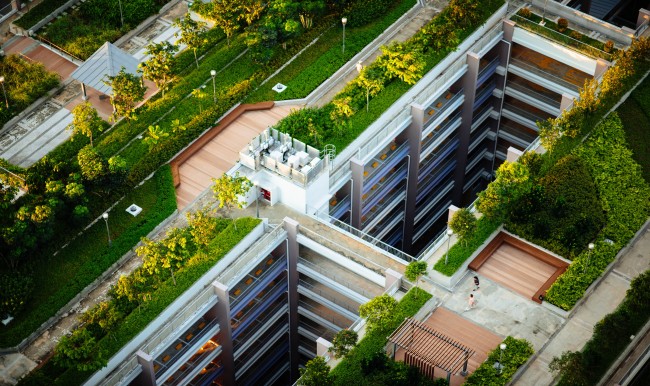Do You Know About Griha Certified Buildings in India
Short Overview About The Griha Certified Buildings in India
With the escalating environmental concerns and the urgent need for sustainable practices, India has witnessed a significant rise in the construction of Griha Certified Buildings in India. One of the leading certifications driving this movement is the Griha (Green Rating for Integrated Habitat Assessment) certification. Developed by the Indian Green Building Council (IGBC) and the Energy and Resources Institute (TERI), Griha has emerged as a benchmark for sustainable construction and design in the country. In this blog, we will explore the significance of Griha certified buildings and their impact on India's sustainable development.
Understanding Griha Certification With Griha Certified Buildings in India:
Griha certification is a holistic evaluation system that assesses the environmental performance of buildings across various parameters, including site selection, energy efficiency, water conservation, waste management, and indoor environmental quality. It emphasizes reducing the environmental footprint of buildings while ensuring the well-being and comfort of occupants. Griha promotes the efficient use of resources, renewable energy adoption, and waste reduction.
Key Features and Benefits:
Griha certification encourages architects, builders, and developers to adopt sustainable practices and design energy-efficient buildings. Here are some key features and benefits of Griha Certified Buildings in India:
- Energy Efficiency:
Griha promotes energy-efficient design through optimal orientation, insulation, efficient HVAC systems, and use of renewable energy sources like solar power. It helps reduce energy consumption and dependency on fossil fuels, leading to lower greenhouse gas emissions.
- Water Conservation:
Water scarcity is a critical issue in many parts of India. Griha encourages rainwater harvesting, wastewater treatment, and efficient plumbing fixtures to minimize water consumption. Such practices contribute to water conservation and improve overall water management.
- Reduced Environmental Impact:
Griha promotes the use of sustainable materials, waste management strategies, and green landscaping techniques. It minimizes the environmental impact associated with construction activities, reduces waste generation, and encourages recycling and reuse.
- Enhanced Indoor Environmental Quality:
Griha focuses on providing a healthy and comfortable indoor environment by addressing factors such as natural lighting, indoor air quality, and thermal comfort. It promotes the use of non-toxic materials and emphasizes proper ventilation and daylighting.
- Economic Benefits:
Griha certification leads to long-term cost savings for building owners and occupants. Energy-efficient design reduces energy bills, while water conservation measures lower water expenses. Additionally, Griha certified buildings often have better market value and higher rental or resale potential.
Impact on Sustainable Development:
The proliferation of Griha certified buildings is contributing to India's sustainable development goals in multiple ways:
- Climate Change Mitigation:
Griha certified buildings significantly reduce carbon emissions, helping combat climate change. They facilitate India's commitment to the Paris Agreement and the global efforts to limit global warming.
- Resource Efficiency:
​​​​​​​By promoting sustainable resource management, Griha reduces the strain on natural resources. It encourages the use of renewable energy sources, efficient water management, and sustainable construction practices, thereby fostering resource conservation.
- Health and Well-being:
​​​​​​​Griha certification prioritizes the well-being of occupants by ensuring healthy indoor environments. Improved air quality, access to natural light, and thermal comfort positively impact the physical and mental health of building occupants.
- Green Job Creation:
​​​​​​​The growing demand for Griha certified buildings is creating a significant market for sustainable construction practices and technologies. This, in turn, generates employment opportunities in the green building sector, driving economic growth.
Griha Certified Buildings in India are leading the way in sustainable construction practices in India. With their focus on energy efficiency, water conservation, reduced environmental impact, and enhanced indoor environmental quality, these buildings play a crucial role in mitigating climate change and promoting sustainable development. As more architects, developers, and building owners embrace Griha certification, India moves closer to its goal.
As the world grapples with the challenges of climate change and environmental degradation, sustainable development has become an imperative for societies worldwide. In India, a growing awareness of the need for eco-friendly infrastructure has led to the emergence of Griha (Green Rating for Integrated Habitat Assessment), a rating system that promotes sustainable design and construction practices. Griha has emerged as a guiding light, encouraging the construction of environmentally responsible buildings across the country. In this blog post, we will delve into the concept of Griha certified buildings in India, exploring their significance, benefits, and their contribution towards a greener future.
What is Griha Certified Buildings in India?
Griha is an indigenous green building rating system developed by The Energy and Resources Institute (TERI) and the Ministry of New and Renewable Energy (MNRE) in India. Launched in 2007, Griha aims to minimize the ecological footprint of buildings while ensuring the well-being and comfort of occupants. It provides a comprehensive framework for evaluating the environmental performance of buildings, including both residential and commercial structures.
The Griha Certification Process:
The Griha certification process evaluates a wide range of parameters, encompassing site selection, energy efficiency, water conservation, waste management, indoor air quality, and sustainable materials. The rating system assigns points to each parameter, and based on the total points achieved, buildings are awarded a Griha rating ranging from one to five stars. A higher star rating signifies a higher level of sustainability and environmental performance.
Benefits of Griha Certified Buildings in India:
- Energy Efficiency:
Griha emphasizes the importance of energy-efficient design, encouraging the use of renewable energy sources and minimizing energy consumption through efficient lighting, insulation, and HVAC (heating, ventilation, and air conditioning) systems. Griha-certified buildings significantly reduce energy bills and contribute to a greener and more sustainable energy future.
- Water Conservation:
Water scarcity is a pressing issue in many parts of India. Griha certification promotes the implementation of water-efficient fixtures, rainwater harvesting systems, and wastewater treatment plants, thereby reducing water consumption and relieving the stress on water resources.
- Improved Indoor Air Quality:
Griha certification ensures the use of non-toxic materials, proper ventilation systems, and natural lighting, resulting in healthier indoor environments for occupants. This contributes to improved productivity, reduced health risks, and enhanced overall well-being.
- Reduced Carbon Footprint:
Through sustainable design practices and the use of renewable energy sources, Griha-certified buildings minimize greenhouse gas emissions, thus playing a vital role in combating climate change.
- Cost Savings:
While initial construction costs of Griha-certified buildings may be slightly higher, they offer significant long-term cost savings through reduced energy and water bills. Moreover, the increased demand for sustainable buildings is leading to a rise in property value, making them attractive investments.
The Impact of Griha Certification:
Griha has gained immense popularity in India, with an increasing number of developers, architects, and construction companies embracing its principles. The certification system has influenced the construction of residential complexes, educational institutions, government buildings, and commercial spaces, fostering sustainable urban development. The widespread adoption of Griha has a cascading effect, inspiring a cultural shift towards environmentally conscious living and building practices.
Griha Certified Buildings in India embody the nation's commitment to sustainable development. By adhering to strict environmental standards, these buildings promote energy efficiency, water conservation, and a healthier living environment. With their numerous benefits, Griha certified buildings pave the way for a greener and more sustainable future. As more stakeholders recognize the significance of sustainable building practices, the adoption of Griha certification will likely continue to grow, contributing to India's journey towards a low-carbon economy and a healthier planet for generations.
As the world grapples with the challenges of climate change and environmental degradation, sustainable practices have become paramount. In India, where urbanization is rapidly transforming skylines, the need for eco-friendly infrastructure has never been more pressing. Griha (Green Rating for Integrated Habitat Assessment), a rating system developed by The Energy and Resources Institute (TERI) in collaboration with the Ministry of New and Renewable Energy, is paving the way for a greener future. In this blog, we will explore the significance of Griha certified buildings and their impact on sustainable living in India.
What is Griha Certified Buildings in India?
Griha Certification is a comprehensive rating system designed to evaluate the environmental performance of buildings in India. It assesses parameters such as site selection and planning, water conservation, energy efficiency, waste management, materials, and resources, as well as indoor environmental quality. Buildings are awarded a rating between one and five stars based on their compliance with Griha's stringent criteria.
Advantages of Griha Certified Buildings in India:
- Energy Efficiency:
Griha certification promotes the adoption of energy-efficient technologies and practices, reducing the overall energy consumption of buildings. This not only lowers carbon emissions but also leads to substantial cost savings for occupants.
- Water Conservation:
By emphasizing water-efficient fixtures, rainwater harvesting, and wastewater management, Griha certified buildings reduce water consumption, contributing to water conservation efforts in water-stressed regions.
- Sustainable Materials:
Griha encourages the use of sustainable and locally sourced materials, reducing the environmental impact associated with long-distance transportation. This promotes the growth of local economies and traditional building practices.
- Indoor Environmental Quality:
The certification ensures that buildings prioritize occupants' health and well-being by implementing measures such as proper ventilation, daylight utilization, and the use of low-toxicity materials. This leads to improved indoor air quality and a healthier living environment.
- Waste Management:
Griha certified buildings incorporate effective waste management systems, including segregation, recycling, and composting. This reduces the burden on landfills and promotes the circular economy.
- Reduced Carbon Footprint:
By promoting renewable energy integration, Griha certified buildings significantly reduce greenhouse gas emissions and contribute to mitigating climate change.
Impact on Sustainable Living in India:
- Environmental Protection:
Griha certified buildings play a pivotal role in mitigating environmental degradation caused by the construction industry. They conserve resources, reduce pollution, and help preserve ecosystems, fostering a sustainable balance between urban development and nature.
- Health and Well-being:
Griha promotes healthier indoor environments by addressing factors such as air quality, thermal comfort, and natural lighting. This improves occupants' health and productivity, leading to a better quality of life.
- Energy Security:
The emphasis on energy efficiency and renewable energy in Griha certified buildings reduces the reliance on conventional energy sources, contributing to India's energy security and promoting a clean energy transition.
- Economic Advantages:
Griha certification promotes the growth of the green building sector in India. It creates employment opportunities, boosts local economies through the use of sustainable materials, and attracts investments in green technologies and innovations.
- Government Support:
The Indian government encourages the construction of Griha certified buildings by offering various incentives, including tax benefits, faster approvals, and grants. This provides an added incentive for developers and promotes widespread adoption of sustainable building practices.
Griha Certified Buildings in India are revolutionizing the Indian construction landscape by prioritizing sustainability, energy efficiency, and occupant well-being. As India strives to achieve its ambitious climate goals and build a resilient future, Griha certification acts as a guiding light for developers, architects, and policymakers. By embracing these green building practices, India can unlock a sustainable, low-carbon future that balances growth with environmental






